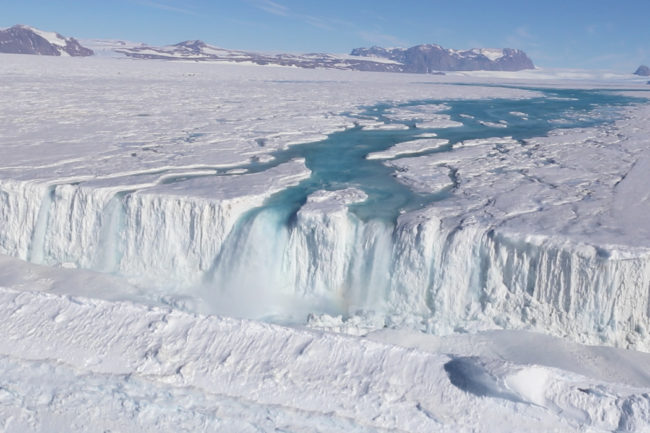
A new paper has been published within the Geophysical Research Letters journal on April 8, 2021. Titled “Surface melt and runoff on Antarctic ice shelves at 1.5°C, 2°C and 4°C of future warming“, it was authored by researchers at the UK’s University of Reading. It presents the results of high-resolution regional climate modelling that predicts in more detail than before the impact of increased melting and water runoff on ice shelf stability.
The content is worrying.
The Abstract
The Abstract reads as follows …
The future surface mass balance (SMB) of Antarctic ice shelves has not been constrained with models of sufficient resolution and complexity. Here, we force the high‐resolution Modèle Atmosphérique Régional (MAR) with future simulations from four CMIP models to evaluate the likely effects on the SMB of warming of 1.5°C, 2°C and 4°C above pre‐industrial temperatures. We find non‐linear growth in melt and runoff which causes SMB to become less positive with more pronounced warming. Consequently, Antarctic ice shelves may be more likely to contribute indirectly to sea level rise via hydrofracturing‐induced collapse, which facilitates accelerated glacial discharge. Using runoff and melt as indicators of ice shelf stability, we find that several Antarctic ice shelves (Larsen C, Wilkins, Pine Island and Shackleton) are vulnerable to disintegration at 4°C. Limiting 21st century warming to 2°C will halve the ice shelf area susceptible to hydrofracturing‐induced collapse compared to 4°C.
What does that really tell us?
Whether Antarctic ice shelves are gaining or losing ice at the surface – their surface mass balance (SMB) – depends on many factors.
To understand future Antarctic ice shelf SMB requires complex computer models, and until now, few studies using these models have been done.
This specific study used the high‐resolution MAR model to explore how ice shelf SMB changes under warming scenarios of 1.5°C, 2°C and 4°C above pre‐industrial temperatures.
Their results show that warming causes surface mass balance to decrease because high temperatures produce meltwater, which then runs off the ice shelves, and that this effect is larger for greater levels of warming. (Well yes, this bit is not exactly a surprise)
Here is something to take note of.
Antarctic ice shelves may contribute to rising sea levels in future because larger amounts of melt and runoff increase their vulnerability to ‘hydrofracturing’, a process whereby ice shelves crack and disintegrate.
How we should respond is of course obvious.
Limiting future warming will reduce the number of ice shelves that will be susceptible to collapse via this mechanism.
Comments
The study reveals that 34% of the area of all Antarctic ice shelves – around half a million square kilometres – including 67% of ice shelf area on the Antarctic Peninsula, would be at risk of destabilisation under 4°C of warming. Limiting temperature rise to 2°C rather than 4°C would halve the area at risk and potentially avoid significant sea level rise.
The researchers also identified Larsen C – the largest remaining ice shelf on the peninsula, which split to form the enormous A68 iceberg in 2017 – as one of four ice shelves that would be particularly threatened in a warmer climate.
“Ice shelves are important buffers preventing glaciers on land from flowing freely into the ocean and contributing to sea level rise. When they collapse, it’s like a giant cork being removed from a bottle, allowing unimaginable amounts of water from glaciers to pour into the sea.
“We know that when melted ice accumulates on the surface of ice shelves, it can make them fracture and collapse spectacularly. Previous research has given us the bigger picture in terms of predicting Antarctic ice shelf decline, but our new study uses the latest modelling techniques to fill in the finer detail and provide more precise projections.
“The findings highlight the importance of limiting global temperature increases as set out in the Paris Agreement if we are to avoid the worst consequences of climate change, including sea level rise.”
Dr Ella Gilbert, a research scientist in the University of Reading’s Department of Meteorology
Fracturing
Ice shelf vulnerability from a fracturing process was forecast under 1.5°C, 2°C and 4°C global warming scenarios, which are all possible this century.
Ice shelves are permanent floating platforms of ice attached to areas of the coastline and are formed where glaciers flowing off the land meet the sea.
Every summer, ice at the surface of the ice shelf melts and trickles down into small air gaps in the snow layer below, where it refreezes. However, in years when there is a lot of melting but little snowfall, the water pools on the surface or flows into crevasses, deepening and widening them until the ice shelf eventually fractures and collapses into the sea. If there is water collecting on the surface of the ice shelf, that suggests it could be vulnerable to collapse in this way.
This is what happened to the Larsen B ice shelf in 2002, which fractured following several years of warm summer temperatures. Its collapse caused the glaciers behind the ice shelf to speed up, losing billions of tonnes of ice to the sea.
The researchers identified the Larsen C, Shackleton, Pine Island and Wilkins ice shelves as most at-risk under 4°C of warming, due to their geography and the significant runoff predicted in those areas.
“If temperatures continue to rise at current rates, we may lose more Antarctic ice shelves in the coming decades.
“Limiting warming will not just be good for Antarctica – preserving ice shelves means less global sea level rise, and that’s good for us all.”
Dr Ella Gilbert, a research scientist in the University of Reading’s Department of Meteorology
